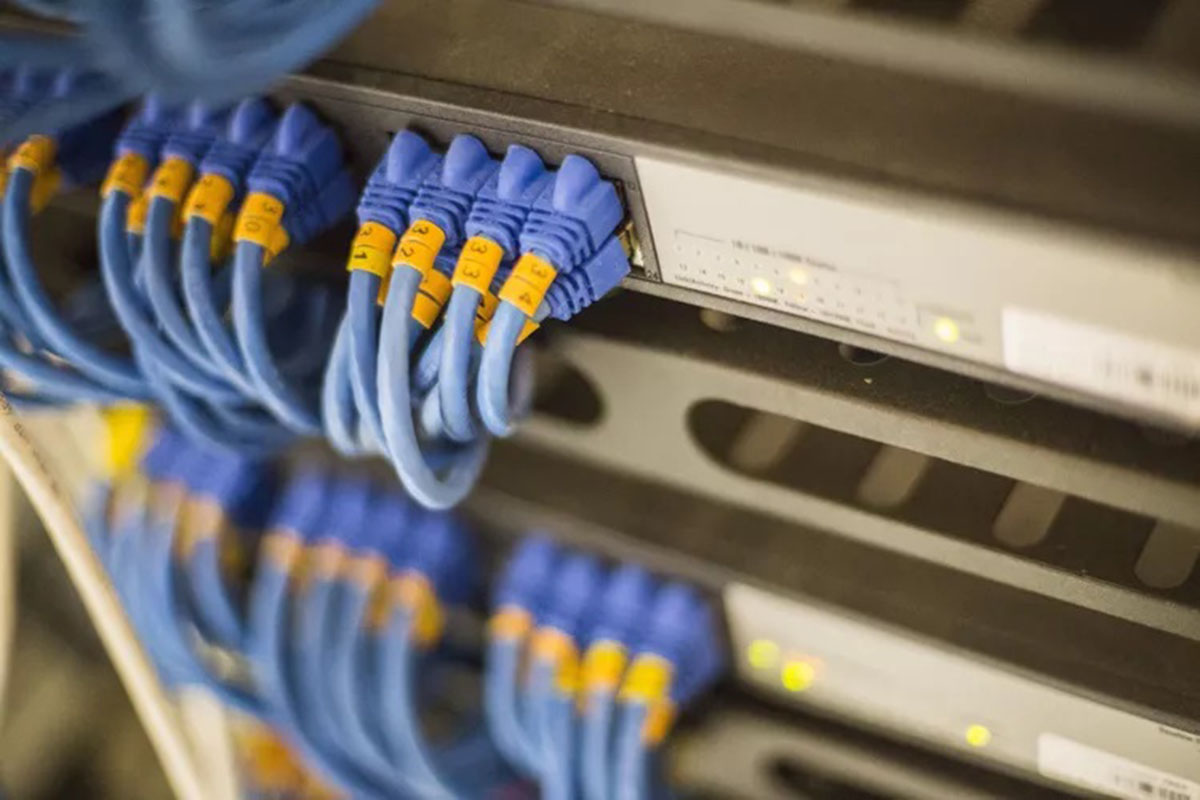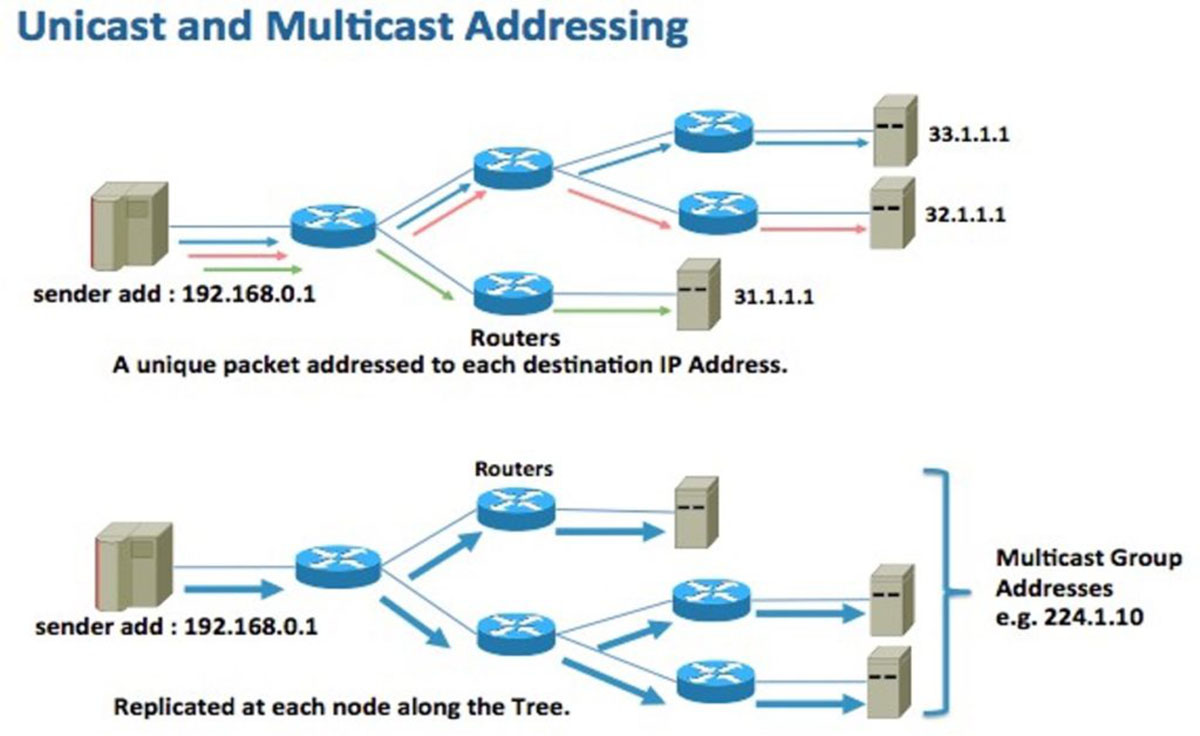Introduction
A router plays a crucial role in computer networks by forwarding data packets from one network to another. To efficiently perform this task, routers use various routing protocols. These protocols govern the process of how routers exchange information and make decisions to determine the best path for forwarding messages. Understanding the protocols used by routers is essential for network administrators and IT professionals involved in designing, managing, and troubleshooting networks.
In this article, we will explore the different routing protocols employed by routers to forward messages. We will dive into the intricacies of routing processes and investigate the various types of routing protocols, including interior gateway protocols (IGPs), exterior gateway protocols (EGPs), distance vector routing protocols, link state routing protocols, and hybrid routing protocols.
By gaining insight into these protocols, you will have a better understanding of how routers communicate and collaborate to efficiently navigate traffic across networks. Let’s delve into the world of routing protocols and uncover the underlying mechanisms that drive the flow of information.
Routing Protocols
Routing protocols are a set of rules and algorithms that enable routers to exchange information and make informed decisions on how to route network traffic. These protocols play a critical role in ensuring efficient and reliable communication between network devices.
There are various types of routing protocols, each with its own advantages and mechanisms. Broadly speaking, routing protocols can be categorized into two main groups: interior gateway protocols (IGPs) and exterior gateway protocols (EGPs).
IGPs are used within an autonomous system (AS) – a network controlled by a single entity. They focus on determining the best paths for routing packets within the same network and are typically used in local area networks (LANs) or enterprise networks. Examples of IGPs include:
- Routing Information Protocol (RIP): A distance vector protocol that uses hop count as its metric to determine the best path for routing packets.
- Open Shortest Path First (OSPF): A link state protocol that calculates routes based on the shortest path algorithm, considering factors such as bandwidth and latency.
- Enhanced Interior Gateway Routing Protocol (EIGRP): A hybrid protocol that combines features of both distance vector and link state protocols, providing fast convergence and load balancing capabilities.
On the other hand, EGPs are used to exchange routing information between different autonomous systems, connecting multiple networks operated by different organizations. The most commonly used EGP is the Border Gateway Protocol (BGP), which enables routers to exchange information about the availability and reachability of networks on a global scale.
Within each IGP and EGP category, there are different sub-categories based on the routing algorithm used. Two popular categories of routing algorithms include:
- Distance Vector Routing Protocols: These protocols rely on a routing table that contains information about the number of hops needed to reach a particular destination. They periodically share routing updates with neighboring routers and make decisions based on the shortest path, determined by the least number of hops.
- Link State Routing Protocols: These protocols rely on the exchange of detailed information about the network topology among routers. Each router builds a database of link states or link-state advertisements (LSAs), allowing them to compute the shortest path to a destination based on various metrics.
Additionally, there are hybrid routing protocols that combine characteristics of distance vector and link state protocols, catering to the specific needs of complex network environments.
Now that we have a fundamental understanding of routing protocols, we will explore some of the most prominent protocols in each category, highlighting their features and advantages.
Overview of Routing Process
The routing process is the mechanism by which routers exchange information and make decisions to forward network traffic. It involves several steps that allow routers to determine the best path for delivering packets to their intended destinations.
At a high level, the routing process consists of the following steps:
- Routing Table Population: Each router maintains a routing table, a database that contains information about available network destinations and the associated paths. This information can be learned through various means, such as dynamic routing protocols or manually configured static routes.
- Path Determination: Once the routing table is populated, the router evaluates the available paths to different destinations. It considers factors such as the metrics defined by the routing protocol, including hop count, bandwidth, delay, and reliability. Based on this evaluation, the router selects the best path for delivering packets.
- Packet Forwarding: After determining the best path, the router forwards the packet to the next hop on that path. This process involves encapsulating the packet in the appropriate data link layer protocol and sending it out through the appropriate interface.
- Update and Exchange of Routing Information: Routers continuously exchange updates about the network topology and availability of routes with their neighboring routers. This ensures that routers have up-to-date information about network changes and allows for efficient rerouting in the event of a link failure or congestion.
- Loop Prevention: One challenge in routing is preventing loops, where packets are continuously circulated between routers without reaching the destination. Routing protocols employ various mechanisms, such as hop count limits, split horizon, and route poisoning, to avoid such loops and ensure efficient packet delivery.
The routing process occurs dynamically, with routers constantly adapting to changes in the network topology to ensure optimal packet delivery. This dynamic nature allows for efficient utilization of network resources, load balancing, and fault tolerance.
While the exact details of the routing process can vary depending on the specific routing protocol and network configuration, the fundamental goal remains the same: to determine the best paths for delivering packets and maintain the integrity and efficiency of the network.
Interior Gateway Protocols (IGPs)
Interior Gateway Protocols (IGPs) are routing protocols that operate within a single autonomous system (AS). They focus on determining the best paths for routing packets within the same network and are commonly used in local area networks (LANs) or enterprise networks.
There are several IGPs, each with its own characteristics and advantages. Let’s explore three popular IGPs:
- Routing Information Protocol (RIP): RIP is a distance vector protocol that uses hop count as its metric to determine the best path for routing packets. It periodically broadcasts its routing table updates to neighboring routers. RIP supports both IPv4 and IPv6 networks and is simple to configure, making it suitable for small to medium-sized networks. However, RIP has limitations, such as a maximum hop count of 15, which can result in suboptimal paths and longer convergence times.
- Open Shortest Path First (OSPF): OSPF is a link state protocol that calculates routes based on the shortest path algorithm, considering factors such as bandwidth and latency. It builds a complete map of the network by exchanging link state advertisements (LSAs) among routers. OSPF offers faster convergence, supports large networks, and provides greater flexibility in route selection. It is well-suited for enterprise networks and provides support for IPv4 and IPv6.
- Enhanced Interior Gateway Routing Protocol (EIGRP): EIGRP is a hybrid protocol that combines features of both distance vector and link state protocols. It uses a more complex metric formula, considering factors such as bandwidth, delay, reliability, and load. EIGRP supports unequal-cost load balancing, provides fast convergence, and minimizes network traffic by only sending incremental updates. It is a Cisco proprietary protocol, making it commonly used in Cisco networks.
IGPs typically exchange routing information using routing protocols such as RIP, OSPF, or EIGRP to maintain an up-to-date view of the network topology. Routers using IGPs share information about network changes, including new routes, link failures, or changes in network metrics, to ensure accurate and efficient routing.
One advantage of IGPs is that they are designed to operate efficiently within a single AS, where routers are under the control of a single organization. This allows network administrators to have full control over routing policies, security measures, and performance optimization within their networks.
By using IGPs, organizations can establish reliable and scalable networks with efficient packet routing, allowing for seamless communication between devices and optimal utilization of network resources.
Exterior Gateway Protocols (EGPs)
Exterior Gateway Protocols (EGPs) are routing protocols used to exchange routing information between different autonomous systems (AS). They assist in connecting multiple networks operated by different organizations and facilitate communication across the internet. The most commonly used EGP is the Border Gateway Protocol (BGP).
Border Gateway Protocol (BGP): BGP is a path-vector protocol that enables routers in different ASs to share information about the availability and reachability of networks. BGP is designed to handle the complexity of routing on a global scale, making it suitable for internet service providers (ISPs) and large enterprise networks. It uses an extensive routing table called the BGP routing table, which contains information about numerous network prefixes and their associated paths. BGP employs policies, attributes, and preferences to make routing decisions and choose the best paths. It provides scalability, flexibility, and extensive control over how routes are advertised and selected.
The main objective of EGPs is to enable routers to exchange routing information across different administrative domains while ensuring efficient and reliable communication. EGPs play a key role in interconnecting autonomous systems, allowing networks to span regional, national, and even international boundaries.
Unlike interior gateway protocols (IGPs) that focus on routing within a single AS, EGPs handle the complexities associated with connecting multiple ASs. They facilitate the exchange of routing information between routers belonging to different organizations, enabling global connectivity and seamless internet routing.
EGPs are important for maintaining the stability and resilience of the internet. They handle the intricate task of routing packets across multiple networks and diverse routing domains. By sharing information about network reachability, EGPs allow routers to make well-informed decisions about the paths they should choose to deliver packets to their destinations.
Furthermore, EGPs ensure that routing updates and changes are appropriately propagated throughout the internet. This helps in maintaining the integrity and efficiency of the global routing system by quickly adapting to network changes, avoiding congestion, and optimizing the selection of optimal paths.
EGPs, especially BGP, are crucial for internet service providers, large enterprises, and any organization involved in interconnecting autonomous systems. They enable efficient and reliable routing across different administrative domains and ensure the global connectivity of networks, allowing for seamless communication across the internet.
Distance Vector Routing Protocols
Distance Vector Routing Protocols are a type of routing protocol that relies on the concept of distance or hop count to determine the best path for routing packets. These protocols periodically exchange routing information with neighboring routers and base their routing decisions on the lowest hop count to a particular destination.
One of the most well-known distance vector routing protocols is the Routing Information Protocol (RIP). RIP uses the hop count as its metric, where each hop represents a router traversed. RIP routers periodically broadcast their entire routing tables to their neighboring routers. This process allows routers to update their routing tables based on the received information.
Distance vector routing protocols have several characteristics:
- Convergence Time: Distance vector protocols typically have slower convergence times compared to other routing protocols. Convergence time refers to the time it takes for routers to update their routing tables and reach a stable state after a network change or failure.
- Routing Loops: Distance vector protocols are prone to routing loops, where packets can continuously circulate between routers without reaching their destination. To mitigate this issue, distance vector protocols implement mechanisms such as split horizon, route poisoning, and hold-down timers.
- Scalability: Distance vector protocols are generally less scalable than other routing protocols. As the network size grows, distance vector protocols may encounter difficulties in managing and exchanging large routing tables.
Despite these limitations, distance vector routing protocols still have their advantages and use cases. They are relatively simple to configure and require less processing power and memory compared to other more complex routing protocols. Distance vector protocols are often used in small to medium-sized networks, such as home networks or small offices, where simplicity and ease of configuration are prioritized over scalability and advanced features.
Examples of distance vector routing protocols include RIP (Routing Information Protocol), IGRP (Interior Gateway Routing Protocol), and EIGRP (Enhanced Interior Gateway Routing Protocol). EIGRP, although a hybrid protocol, includes a distance vector component in its operation.
Overall, distance vector routing protocols have played a significant role in the development of routing protocols, providing a foundation for understanding routing concepts and serving as a starting point for network administrators and engineers looking to implement routing in their networks.
Link State Routing Protocols
Link State Routing Protocols are a type of routing protocol that focuses on the exchange of detailed information about the network’s topology among routers. Unlike distance vector protocols, link state protocols provide routers with a complete map of the network, allowing them to calculate the shortest path to a destination based on various metrics.
One popular example of a link state protocol is the Open Shortest Path First (OSPF) protocol. OSPF uses the link state database, which contains information about network links and routers, to build and maintain a map of the network. OSPF routers share link state advertisements (LSAs) with their neighboring routers, allowing each router to possess a full view of the network topology.
Link state routing protocols have several key characteristics:
- Shortest Path Calculation: Link state protocols use advanced algorithms, such as Dijkstra’s algorithm, to calculate the shortest path to a destination. This calculation considers various factors, such as link bandwidth, latency, and network congestion, to determine the optimal path.
- Scalability: Link state protocols are generally more scalable than distance vector protocols. Each router only needs to store information about its directly connected links and does not need to maintain a full routing table. This allows link state protocols to handle larger networks with greater efficiency.
- Fast Convergence: Link state protocols offer faster convergence times compared to distance vector protocols. When a network change occurs, such as a link failure or addition of a new router, only the affected routers need to update their link state information and recalculate paths.
Link state routing protocols provide advanced features and capabilities, making them suitable for large enterprise networks, ISPs, and complex network environments. By considering multiple metrics and utilizing a complete view of the network, link state protocols can make more informed routing decisions and adapt to changing network conditions more efficiently.
In addition to OSPF, other examples of link state routing protocols include Intermediate System to Intermediate System (IS-IS) and the Enhanced Interior Gateway Routing Protocol (EIGRP), which functions as both a distance vector and a link state protocol.
Link state routing protocols have played a crucial role in modern networking. They provide robustness, scalability, and faster convergence, making them essential for large-scale networks where efficient routing and quick response to network changes are essential.
Hybrid Routing Protocols
Hybrid Routing Protocols combine elements of both distance vector and link state protocols to offer a balance between simplicity and flexibility. These protocols aim to provide the advantages of both routing approaches, catering to the specific needs of complex network environments.
One prominent example of a hybrid routing protocol is the Enhanced Interior Gateway Routing Protocol (EIGRP). EIGRP incorporates distance vector mechanisms, such as hop count, with advanced features inspired by link state protocols. It uses diffusing update algorithm (DUAL) to ensure loop-free paths and make efficient routing decisions based on a composite metric that considers factors like bandwidth, delay, reliability, and load.
Hybrid routing protocols possess the following characteristics:
- Fast Convergence: Hybrid protocols, like their link state counterparts, offer faster convergence times. They use updated routing information to quickly adapt to network changes and compute new paths accordingly.
- Scalability: Hybrid routing protocols are designed to handle large networks efficiently. They manage routing tables more effectively, resulting in improved scalability compared to pure distance vector protocols.
- Flexibility: Hybrid protocols allow network administrators to define and prioritize specific routing attributes, such as a preference for certain paths or the use of multiple routing metrics. This flexibility enables fine-tuning of routing decisions to meet specific requirements.
By combining the best aspects of distance vector and link state protocols, hybrid routing protocols offer a reliable and adaptable solution for complex networks. They strike a balance between simplicity, scalability, and advanced features, making them an attractive choice for diverse network environments. Hybrid routing protocols are often used in enterprise networks, where customization and optimization of routing policies are essential.
Aside from EIGRP, other examples of hybrid routing protocols include the Cisco Discovery Protocol (CDP) and the Routing Information Protocol Version 2 (RIPv2), which incorporates some link state features while retaining its distance vector foundation.
Hybrid routing protocols have revolutionized the networking industry by providing an effective middle ground between pure distance vector and link state protocols. They deliver fast convergence, scalability, and flexibility, allowing network administrators to design and manage networks that meet the specific needs of their organizations.
Border Gateway Protocol (BGP)
The Border Gateway Protocol (BGP) is the primary exterior gateway protocol used to exchange routing information and facilitate communication between different autonomous systems (AS) in the internet. BGP plays a critical role in connecting networks operated by different organizations, allowing for global connectivity and seamless routing across multiple ASs.
BGP utilizes a path-vector protocol, where routers exchange information about network reachability and the available paths to specific destinations. It operates based on the principle of selecting the best path, considering various factors and policies defined by network administrators.
Key features and characteristics of BGP include:
- Path Selection: BGP uses attributes, policies, and various metrics to determine and select the optimal path for routing packets. These attributes can include path length, network policies, BGP communities, and local preference, among other factors. Path selection in BGP is highly customizable and allows network administrators to define their own routing policies.
- Internet Routing: BGP is the protocol used to establish and maintain connectivity between ASs in the global internet. It allows ISPs and large organizations to exchange routing information and advertise their network prefixes to ensure proper packet delivery across the entire internet.
- Reliability and Redundancy: BGP is designed to ensure high reliability in routing by continuously monitoring network reachability and responding to changes in the internet topology. It can quickly adapt to link failures or congested paths by rerouting traffic along alternative paths.
- Scalability: BGP’s hierarchical structure and incremental updates make it highly scalable. It allows for efficient management of a vast number of network prefixes, minimizing the amount of routing information exchanged between routers.
BGP is widely used by internet service providers (ISPs), large enterprise networks, content providers, and organizations with complex network infrastructures. Its ability to handle large-scale routing, support policy-based routing, and ensure connectivity on a global scale has made it the de facto standard for inter-domain routing.
BGP is a complex protocol that requires expertise to configure and manage effectively. Network administrators need to carefully plan and implement BGP policies to optimize network performance, ensure security, and maintain stable and efficient routing across the internet.
Overall, BGP’s role in routing information exchange and interconnecting different ASs is crucial for the functioning of the internet. It enables seamless communication, global connectivity, and efficient routing on a massive scale.
Open Shortest Path First (OSPF) Protocol
The Open Shortest Path First (OSPF) protocol is a widely used link state routing protocol that operates within a single autonomous system (AS). OSPF is designed to determine the shortest path and facilitate efficient routing in IP networks, making it particularly suitable for enterprise networks and large-scale deployments.
OSPF utilizes a hierarchical network structure, dividing the network into areas to improve scalability and reduce routing overhead. Each OSPF router maintains a detailed map of its local network connections and exchanges link state information with neighboring routers to construct a topological view of the entire network.
Key features and characteristics of OSPF include:
- Path Calculation: OSPF uses the Dijkstra algorithm to calculate the shortest path based on a combination of factors, including link cost, bandwidth, and network congestion. This enables efficient and optimized routing decision-making.
- Hierarchical Design: OSPF allows for hierarchical network design by dividing the network into different areas. This reduces the complexity of routing tables and limits the scope of flooding link state information, resulting in faster convergence times and improved scalability.
- Scalability: OSPF is highly scalable and can handle networks of various sizes. The protocol divides the network into multiple areas, each with its own routing information and summarization techniques. This minimizes the amount of routing information that needs to be exchanged, optimizing network performance.
- Fast Convergence: OSPF reacts quickly to network changes, adapting routing paths and reconfiguring the network based on updated link state advertisements (LSAs). The use of designated routers (DR) and backup designated routers (BDR) further enhances efficiency and reduces overhead in multi-access networks.
OSPF supports multiple network types, including point-to-point, broadcast multi-access, and virtual links, offering flexibility to accommodate different network environments. It also integrates security features, such as authentication, to protect against unauthorized network access and ensure the integrity of OSPF routing information.
OSPF is widely adopted in enterprise networks due to its scalability, flexibility, and fast convergence times. It provides network administrators with granular control over routing policies, allowing them to prioritize specific paths, implement load balancing, and define route summarization to optimize routing efficiency.
Overall, OSPF serves as a reliable and efficient link state routing protocol that enables optimal routing decision-making within autonomous systems. Its robustness and extensive features make it a preferred choice for large-scale networks that require dynamic and adaptable routing capabilities.
Routing Information Protocol (RIP)
The Routing Information Protocol (RIP) is one of the oldest and simplest distance vector routing protocols. It is designed for small to medium-sized networks and offers a straightforward approach to routing. RIP uses hop count as its metric, with each hop representing a router traversed in the path to a destination.
RIP routers exchange routing table updates with their neighboring routers at regular intervals, typically every 30 seconds. These updates contain information about reachable networks and their associated hop counts. RIP propagates these updates throughout the network, allowing routers to maintain consistent routing tables.
Key features and characteristics of RIP include:
- Hop Count Metric: RIP uses a hop count as its metric to determine the best path. It selects the route with the fewest number of hops as the optimal path to a destination. However, due to the maximum hop count limit of 15, RIP may not be suitable for larger networks.
- Periodic Updates: RIP routers exchange full routing table updates at regular intervals, regardless of whether there have been any network changes. This periodic behavior results in additional network traffic but ensures that routers have up-to-date routing information.
- Convergence Time: RIP has slower convergence times compared to other routing protocols. When a network change occurs, routers rely on the periodic updates to gradually update their routing tables, potentially leading to longer convergence times.
- Route Poisoning and Split Horizon: RIP implements mechanisms like route poisoning and split horizon to prevent routing loops. Route poisoning involves marking unreachable routes with infinite metric values to inform other routers of their unavailability, while split horizon prevents a router from advertising a route back through the interface from which it was learned. These mechanisms enhance the stability of RIP-based networks.
RIP versions include RIP v1, which supports only IPv4, and RIP v2, which includes support for both IPv4 and IPv6 networks, as well as additional features like packet authentication and route summarization.
Due to its simplicity, RIP is relatively easy to configure and deploy, making it suitable for small networks or as a temporary solution during network migrations. However, its limitations in terms of scalability and slow convergence times make it less suitable for larger, more complex networks.
Despite its older technology, RIP continues to be used in certain scenarios where simplicity and ease of implementation are valued over advanced functionality. However, in practice, RIP is often replaced by more sophisticated routing protocols like OSPF or EIGRP in larger networks.
Enhanced Interior Gateway Routing Protocol (EIGRP)
The Enhanced Interior Gateway Routing Protocol (EIGRP) is a hybrid routing protocol that combines characteristics of both distance vector and link state protocols. EIGRP was developed by Cisco Systems and is commonly used in Cisco networks. It offers advanced features, fast convergence, and scalability, making it suitable for medium to large networks.
EIGRP utilizes the diffusing update algorithm (DUAL) to ensure loop-free paths and make efficient routing decisions. It calculates a composite metric, taking into account factors such as bandwidth, delay, reliability, and load, rather than relying solely on hop count like traditional distance vector protocols.
Key features and characteristics of EIGRP include:
- Fast Convergence: EIGRP has fast convergence times, allowing routers to quickly adapt to network changes and update their routing tables. It achieves this through incremental updates and the use of successor and feasible successor routes.
- Scalability: EIGRP scales well in larger networks. It reduces routing overhead by only exchanging incremental updates when there are changes in the network. Additionally, EIGRP supports route summarization, providing efficient routing table management.
- Load Balancing: EIGRP supports unequal-cost load balancing, enabling efficient utilization of multiple paths to a destination by considering the composite metric. This helps to optimize network performance and distribute traffic evenly across available links.
- Loop Prevention: EIGRP utilizes various mechanisms to prevent routing loops, such as the split horizon rule and the hold-down timer. These features enhance the stability and reliability of EIGRP-based networks.
EIGRP is designed for Cisco networks and is generally compatible with both IPv4 and IPv6. It operates within a single autonomous system (AS), making it well-suited for enterprise networks where complex routing policies and customization are required.
One significant advantage of EIGRP is its efficient use of network resources. It minimizes the amount of routing update traffic by only sending incremental updates when there are changes in the network, reducing bandwidth consumption and improving overall network performance.
Overall, EIGRP offers a balance between the simplicity of distance vector protocols and the advanced features of link state protocols. Its fast convergence, scalability, and load balancing capabilities make it a preferred choice for many network administrators managing medium to large-sized Cisco-based networks.
Internet Control Message Protocol (ICMP)
The Internet Control Message Protocol (ICMP) is a network protocol that operates at the network layer of the Internet Protocol suite. It is responsible for error reporting, diagnostics, and generating informational messages between network devices.
ICMP is primarily used by hosts and routers to communicate network-related issues, such as unreachable hosts, network congestion, or time exceeded messages. It is an integral part of network troubleshooting and plays a crucial role in network management and monitoring.
Some key features and functions of ICMP include:
- Error Reporting: ICMP is used to report errors and anomalies encountered during packet delivery. For example, when a host or router cannot deliver a packet, it can generate an ICMP message and send it back to the source, conveying information about the error.
- Network Diagnostics: ICMP supports diagnostics such as ping and traceroute. Ping uses ICMP Echo Request and Echo Reply messages to check the reachability of a host or measure network latency. Traceroute uses ICMP Time Exceeded messages to determine the path taken by packets from a source to a destination.
- Fragmentation Control: ICMP facilitates the fragmentation and reassembly of IP packets. When a router receives a packet that exceeds the Maximum Transmission Unit (MTU) of an outbound interface, it can generate an ICMP “Packet Too Big” message, allowing the source to adjust the packet size accordingly.
- Path MTU Discovery: ICMP assists in Path Maximum Transmission Unit (PMTU) discovery. When a packet encounters a link with a smaller MTU than the packet size, the router can send an ICMP “Fragmentation Needed” message to the source, indicating the appropriate MTU for the path.
ICMP messages are encapsulated within IP packets and have their own message types and codes. ICMP relies on the underlying IP protocol for delivery and does not guarantee reliable packet transmission itself.
ICMP is an essential protocol for network diagnostics and troubleshooting. Its error reporting and diagnostic functions enable network administrators to identify and resolve network issues efficiently. ICMP messages help in identifying such problems as connectivity failures, network congestion, or issues related to packet size and fragmentation.
It is important to note that while ICMP is crucial for network management, some of its functions can potentially be misused for malicious purposes. As a result, network administrators might selectively block or limit certain ICMP messages to enhance network security.
Conclusion
In this article, we have explored various routing protocols that play a crucial role in efficiently forwarding messages in computer networks. Understanding these protocols is essential for network administrators and IT professionals involved in designing, managing, and troubleshooting networks.
We began our discussion by introducing the concept of routing protocols and their significance in the networking field. We explored the two main categories: interior gateway protocols (IGPs) and exterior gateway protocols (EGPs).
Interior gateway protocols (IGPs) are used within a single autonomous system and focus on determining the best paths within the same network. Examples of IGPs include RIP, OSPF, and EIGRP. Each protocol has its own advantages and characteristics, catering to different network requirements.
Exterior gateway protocols (EGPs) enable the exchange of routing information between different autonomous systems, connecting networks operated by various organizations. The Border Gateway Protocol (BGP) is a prominent EGP used to establish and maintain connectivity on a global scale.
We also discussed distance vector routing protocols, such as RIP, which use hop count as their metric, and link state routing protocols, such as OSPF, which provide detailed information about network topology. Additionally, hybrid routing protocols like EIGRP combine elements of both distance vector and link state protocols to offer flexibility and efficiency.
Furthermore, we explored the Internet Control Message Protocol (ICMP), which assists in error reporting, diagnostics, and network management. ICMP is vital for network troubleshooting and includes functions such as ping, traceroute, and fragmentation control.
In conclusion, understanding routing protocols is vital for effective network design, implementation, and management. Each protocol offers its own advantages and features, enabling efficient routing decision-making and reliable communication between network devices. By leveraging the appropriate routing protocols, network administrators can optimize network performance, ensure scalability, and troubleshoot network issues effectively.

























